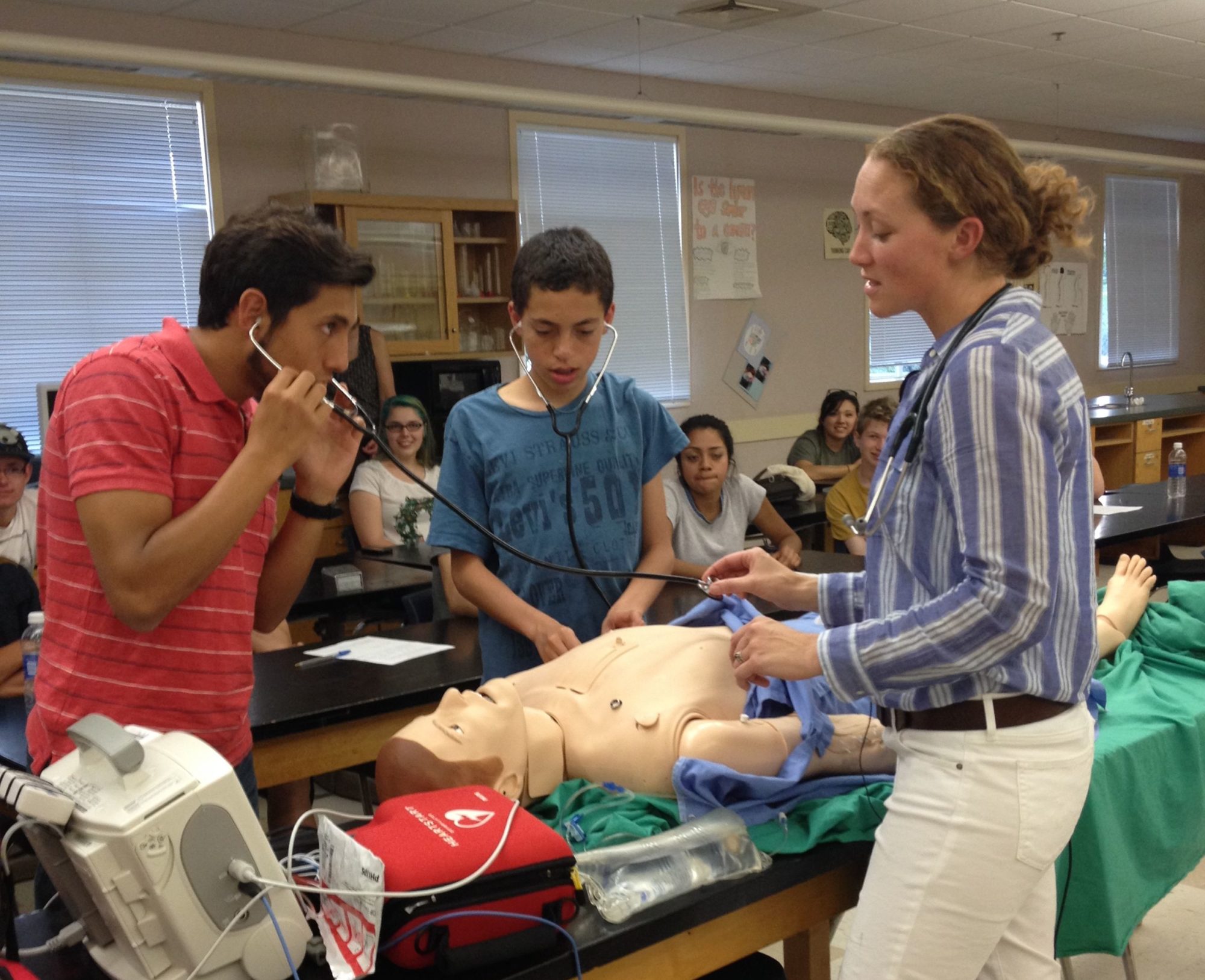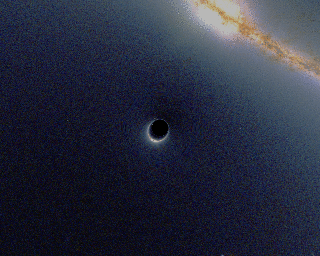By Talya Klinger, Homeschooler
Contrary to popular opinion, black holes do not exist solely to swallow up your socks, keys, and the last scoop of Rocky Road you were saving for a late night snack. Rather, a black hole is an object with such a large mass in such a small volume that nothing, not even light, can escape its gravitational pull. The black hole’s gravitational pull absorbs whatever is in its reach.
The outer limit of a black hole is an imaginary surface called its event horizon, where the black hole’s gravitational pull is just strong enough that not a single photon can escape, creating a large dark space. According to Einstein’s theory of general relativity, even light rays that pass by the event horizon are bent and distorted by the black hole’s gravity in a process called gravitational lensing.
This simulation of a spinning supermassive black hole from the movie Interstellar is approximately what a black hole would look like, according to general relativity.
As black holes absorb more and more objects, their mass grows. Not all black holes grow to a similar size, however. Depending on their mass, black holes generally fall into two radically different size categories: stellar mass and supermassive. Most stellar mass black holes, which are 10 to 24 times the size of the sun, are isolated and difficult to detect. Supermassive black holes, on the other hand, are millions or billions of times the size of the sun and are found at the center of most large galaxies, such as the Milky Way. Even when supermassive black holes are not absorbing matter, scientists can observe the effects such black holes have on the stars and gases around them. While stellar mass black holes are more difficult to detect unless they are in the process of absorbing matter, scientists know more about how they form than they do about the formation of supermassive black holes.
A simulation of gravitational lensing around a black hole and a galaxy
Many of the properties of black holes are well documented, yet the formation and growth of supermassive black holes are on the cutting edge of astrophysics. Black holes usually form out of supernovas – the explosions at the end of a star’s lifespan. In young or middle-aged stars, the energy created by nuclear fusion counteracts gravity, and keeps a star from collapsing into a black hole. When a massive star reaches the end of its lifespan (when it has burned all the fuel inside of it), it explodes in a phenomenon known as a supernova. Because fusion cannot occur in the remnants of a supernova, when there is not enough energy for the supernova to counteract gravity, there is nothing to prevent the remaining matter from collapsing into a dense object, such as a black hole. By astronomical standards, only supermassive stars have enough matter to become black holes, so small stars, including our sun, merely compact into white dwarfs or neutron stars. (Spoiler alert: the sun will eventually become a white dwarf, so there is no danger of it becoming a black hole.) Scientists know more about the creation of stellar-mass black holes than about the creation of supermassive black holes, but there is a possibility that stellar-mass black holes can grow to a supermassive size by rapidly consuming the matter around them.
Once a black hole forms, it can continue to grow by absorbing more and more matter. The following is theoretical. For example, in binary star systems containing two large stars, the first star to become a black hole will absorb matter from its companion star until the younger star vanishes. When black holes are too far from stars to absorb their matter, they consume the dust and gas floating around them. When two black holes collide, it has been hypothesized that they merge together to become an even larger black hole, producing a whopping amount of energy and sending ripples known as gravitational waves through the universe.
A stellar-mass black hole in a binary star system
So far, the only observations of gravitational waves have been contradicted by other, more detailed observations. However, as pairs of supermassive black holes at the centers of distant galaxies spiral closer and closer to each other, the chances are good that we will eventually be able to observe and study such dramatic black hole growth.
For more information, come to the next Marin Science Seminar at Terra Linda High School from 7:30-8:30 p.m. on March 11th, 2015.
Sources:
Image Credits:
 research focus on 21-cm emission from neutral hydrogen. He obtained his PhD from the University of Edinburgh, Scotland, in the fields of sub-millimeter galaxy evolution and the coupled growth of galaxies and black holes. In 2007 Dr. Targett began a research postdoc at Caltech, followed by similar appointments at the University of Birmingham (UK), the University of British Colombia, and the University of Edinburgh. He is currently an Associate Professor of Astronomy and Physics at Sonoma State University.
research focus on 21-cm emission from neutral hydrogen. He obtained his PhD from the University of Edinburgh, Scotland, in the fields of sub-millimeter galaxy evolution and the coupled growth of galaxies and black holes. In 2007 Dr. Targett began a research postdoc at Caltech, followed by similar appointments at the University of Birmingham (UK), the University of British Colombia, and the University of Edinburgh. He is currently an Associate Professor of Astronomy and Physics at Sonoma State University.


 MSS interns attend and assist with a minimum of 6 science seminars per academic year (there are 12 per year) during which they meet the speakers and assist with various logistical duties. Sessions take place on Wednesday evenings at Terra Linda High School, Room 207, during the school year. Interns arrive evening of a session at 7 pm and are free to leave once breakdown is completed (between 8:30 and 9 pm).
MSS interns attend and assist with a minimum of 6 science seminars per academic year (there are 12 per year) during which they meet the speakers and assist with various logistical duties. Sessions take place on Wednesday evenings at Terra Linda High School, Room 207, during the school year. Interns arrive evening of a session at 7 pm and are free to leave once breakdown is completed (between 8:30 and 9 pm). 










